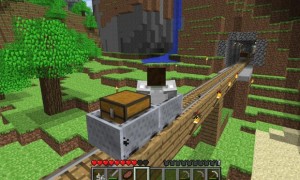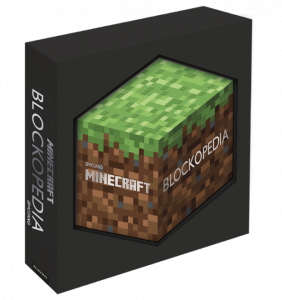What is Minecraft? It’s a game, obviously: one that its developer Mojang has sold nearly 54m copies of across computers, consoles and mobile devices so far.
It’s a series of books published by Egmont that sold more than 1.3m copies in the UK alone in the first eight months of 2014. It’s a range of Lego kits that have been selling out rapidly, as well as the source for a line of plush toys, hoodies and other products sold from Mojang’s online store.
But Minecraft is also an educational tool in schools through the MinecraftEdu initiative, and the driver for Block by Block, a partnership with the United Nations Human Settlements Programme to get young people involved in planning public urban spaces, starting with a pilot in Kenya.
Minecraft is also one of YouTube’s most popular video categories – right up there with music – fuelling hugely popular channels like Stampy (the fourth biggest YouTube channel in the world in August with 217.9m views) and The Diamond Minecart (sixth with 190.6m views).
Oh, and at some point in the next 3-4 years, Minecraft will also be a movie, courtesy of a deal between Mojang and Hollywood studio Warner Brothers.
It’s unsurprisingly one of the key topics for nosy questions when The Guardian interviews Mojang’s chief operating officer Vu Bui, ahead of his keynote speech this week at London’s Brand Licensing Europe conference.
A Minecraft film? When’s it coming out? “I still have no idea. A long time. I’m going to guess three years, but it could be four, probably not two. 3-4 years seems to be a reasonable bet,” says Bui, stressing that the project remains in its early days of development.
In February, news site Deadline provided initial details, suggesting that the Minecraft movie would be live-action, and produced by Roy Lee and Jill Messick – Lee having previously produced The Lego Movie, which should bode well.
Advertisement
“We were approached by so many studios, but after talking to Warner Bros, we decided that this are absolutely the team we want to work with,” says Bui. “They respect the brand, respect the IP, and want to make something that is going to be awesome, not just capitalise on the success of the game.”
Is it really live-action? Who’s in it? Bui chuckles as he parries the question. “A movie takes years, especially a large-budget movie like this. It’s still in the beginning stages, and there really isn’t a clear picture yet of what this is going to be. Once there is, I’m sure we’ll share more.”
He’s very clear on one point though: whatever story the Minecraft movie tells, it will just be one story among many possible, matching the way there is no single ‘right’ way to play Minecraft as a game.
“We don’t want any story that we make, whether it’s a movie or a book, to create some sort of ‘this is the official Minecraft, this is how you play the game’ thing. That would discourage all the players who don’t play in that way,” says Bui. “When coming up with a story, we want to make sure it is just a story within Minecraft, as opposed to the story within Minecraft.”
There are plenty of other things to talk about when it comes to the business around Minecraft, which Bui says is still overseen by a tiny core team within Mojang – mainly art director Markus ‘Junkboy’ Toivonen and director of fun Lydia Winters. Yes, that is her job title.
“Every product that exists out there officially, they have gone over pixel-by-pixel, and for the books, page-by-page. We keep all our approvals in-house – we don’t use any licensing agents – and we are very hardcore about those approvals, to make sure each product is something we believe in,” says Bui.
Earlier this year, Angry Birds maker Rovio revealed that 47% of its income in 2013 came from its consumer products division. Minecraft products may be selling well, but for Mojang, the emphasis in its business is still firmly tilted in favour of gaming.
“Licensing is a small portion of our business, and we want to keep it that way. We’re a games studio, and I don’t think that’s going to change any time soon,” says Bui.
“But people do want to have something physical in their life when they’re not in front of a screen. When we make merchandise, we’re thinking about making something for the people who want it and love it, not just as a source of revenues.”
Mojang’s partnership with Egmont has been positive for both companies, but particularly the latter – and the wider children’s books market.
In an appearance at a conference in July, the publisher’s international CEO Rob McMenemy told the audience that in the UK “the children’s book market year-on-year grew by 11%” in 2013. When asked why, he gave a one-word answer: “Minecraft”.
The first four Minecraft books have sold well, in part because they provide some of the tutorial content – from fighting to building – that isn’t in the game itself (even if it is available online as part of the official Minecraft Wiki). The next book, Blockopedia, is a hexagonal-shaped tome exploring individual blocks from the game.
“We didn’t want to make standard-type annuals with graphics all over the cover and every page a Where’s Waldo? Those type of things we weren’t interested in. We wanted to make it valuable: something that people would buy and treasure, instead of simply flipping through then tossing aside,” says Bui.
“If you see the initial pages before our input, and the final product, it’s literally night and day. As a book publisher, Egmont were very concerned with things like the covers: that they look like a more mature book that wouldn’t fit the target audience. But we don’t have a target audience, we don’t look to a particular demographic.
“We have younger people playing on mobile up to people on their 70s and 80s playing with their grandchildren. Yes, most of our customers are skewed towards the younger ages, but people of all ages can enjoy and appreciate them. The books stand out on the shelves, and we’re proud of that.”
Minecraft as a brand isn’t just about commercial products. Bui is just as enthusiastic about MinecraftEdu, citing a stat that’s been circulating internally that 1m students have used it in schools.
“It’s pretty exciting that a game is being used by teachers not just as a reward – do your classwork then you can play Minecraft for 15 minutes – but actually as an educational tool, with teachers developing a curriculum within the game,” he says.
“It’s very interesting to think that in the future, there will be architects and city planners and all these types of people who grew up using Minecraft, and who’ll be applying those skills in ways that change the world.”
The era of skyscrapers with chickens embedded in the walls beckons. But Block by Block shows the seriousness of Mojang’s intent to find out how Minecraft really can be used by people to take more of a role in urban planning: a bridge between citizens and professional architects, rather than trying to replace the latter.
“We’ve got people in slum areas, many of whom have never used a computer, learning how to use Minecraft to have an input into the redesign and reconstruction of public spaces. It’s beyond being a game, to being used as a layman’s architectural tool,” says Bui.
“Then the architect comes in and turns that into what can actually be built. You need that architect still! But previously there wasn’t a good way for local stakeholders to communicate with architects: they didn’t speak the same language. Now that communication can be done through Minecraft.
The conversation turns back to licensing, but not the big partnerships with the likes of Lego, Egmont and Warner Bros. How about people within the Minecraft community making and sharing… well, not necessarily products, but things: from knitted toys to birthday cakes? How does Mojang work with them?
“We want people to be creative, and we are working on ways to help people to that. We have something coming out soon – in the next month or so hopefully – that will clarify what people can do with the brand,” says Bui.
“It’s really amazing what people are doing out there. What’s not interesting to me is when people just take our existing graphics, slap them onto another product and sell it. There’s no reason those products should be out there. But our approach has always been soft: we talk to people and say ‘hey, this isn’t cool’ or ‘hey, this would be cool if you changed it in that way…’”
It will be interesting to see how those new guidelines continue this softly-softly approach to brand protection. With Mojang in the process of being bought by Microsoft for $2.5bn, any misstep is likely to be brandished as evidence of a culture change under the new ownership, even if Microsoft has nothing to do with it.
An interesting point: Bui says the guiding light behind Mojang’s policies is its desire to encourage creativity. “We get a number of emails a week asking if someone can get the licence for Minecraft birthday supplies: plates and hats and streamers,” he says.
“But if you do a Google search for ‘Minecraft birthday’ you’ll see all kinds of creativity from families who went out to the store, didn’t find Minecraft stuff, and so created it themselves. Why would we want to put out the official Minecraft cake-topper then, when the game is all about creativity?
“Once you put out the official one, people would buy it because it’d be easier than making it themselves. We’re more interested in what people make for themselves: it’s way more exciting for us to have people sitting together and having ideas for Minecraft parties, rather than us just selling some cheesy Minecraft products.”
The last topic the Guardian discusses with Bui is Minecraft videos on YouTube, from the hugely-popular channels like Stampy and The Diamond Minecart to the videos uploaded by fans of all ages showing their exploits in the game.
Bui says that Mojang’s approach to YouTube was defined very early on by the game’s creator, Notch, who ensured that people could use Minecraft assets, sounds and gameplay footage on YouTube without having to ask permission or share any of the resulting advertising revenues.
Earlier in 2014, Nintendo was criticised for filing copyright claims against some YouTubers uploading “Let’s Play” videos of its games, inserting its own ads, which left the video creators unable to earn money from their work. Nintendo said it was working on an affiliate program to share revenues with YouTubers, but its approach was still compared – often negatively – with Mojang’s hands-off policy.
“We have a whole slew of people who are making their entire living just off making videos about Minecraft. Just the economics of that – how many people are making a living off this one IP – is pretty awesome,” says Bui.
“That doesn’t take anything away from us, and I would say it actually adds value to Minecraft, to have people who are extremely talented and creative doing things. We’ve essentially outsourced YouTube videos to a community of millions of people, and what they come up with is more creative than anything we could make ourselves.”
There are limits: Mojang’s rule is that uploading videos to YouTube is fine, but selling them on iTunes or other video-on-demand services is not – the key being whether creators are charging fans.
“There’s no damage to us from YouTube. We might have some people who make content we might not agree with, but this is how the democratisation of media works. You put it out there and let the community decide,” says Bui. “If someone’s putting out rubbish, the community is not going to watch it, and it won’t rise to the top.”
The sheer scale of Minecraft as a brand, a community and a cultural touchpoint means Mojang won’t always be able to avoid criticism and online backlashes over the way it manages the game.
A recent controversy over how players can and can’t make money from the Minecraft servers that they run is the latest proof of that. Even so, Bui says that Mojang’s desire to retain its focus as a games studio, as well as its respect for the community around Minecraft, will serve it well.
“As I said, we want to make most of our money from selling games. We’re not here to penny-pinch the creatives out there using our property to create cool content,” he says. “We have this massive group of people creating amazing things. Why would we want to hinder that in any way?”


